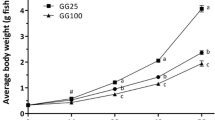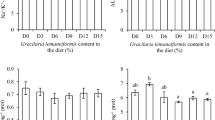Abstract
A feeding trial was conducted to investigate the effects of the dietary incorporation of autoclaved and raw (non-autoclaved) Ulva meal on juvenile rainbow trout (Oncorhynchus mykiss) growth, nutrient utilization, body composition, diet digestibility and fatty acid composition. An algae-free control diet and four experimental diets with either 5 or 10 % inclusion levels of raw Ulva meal (5 % = RU5; 10 % = RU10) or autoclaved Ulva meal (5 % = AU5; 10 % = AU10) were formulated. Fish were fed three times daily to apparent satiation for 12 weeks. The growth of fish fed RU10 (final weight = 76.7 ± 3.31 g; SGR = 2.8 ± 0.05 %) diet was significantly higher than that in fish fed the AU10 diet (67.5 ± 1.61 g; SGR = 2.6 ± 0.03 %). The feed conversion ratio (FCR) was significantly better in fish fed the RU10 diet (0.9 ± 0.06) compared with control diet (1.0 ± 0.06). Condition factor, viscerosomatic index and dress-out remained unaffected by dietary treatment. The hepatosomatic index (HSI) was significantly lower (P < 0.05) in fish fed the AU10 diet (1.2 ± 0.19) than fish fed the other diets (≥1.6). The level of eicosapentaenoic acid (20:5n-3—EPA) in muscle from fish fed the RU10, AU5 and AU10 diets was significantly higher than in fish fed control diet (P < 0.05). Dietary inclusion of Ulva meals resulted in a significant increase in muscle docosapentaenoic acid (22:5n-3—DPA) levels at the end of the feeding period. The results indicate that the dietary inclusion of raw Ulva meal at levels of up to 10 % can be used without significant negative effects on the growth performance, nutrient utilization, dietary digestibility and muscle fatty acid composition. In fact, the inclusion of dietary raw and autoclaved Ulva meal elevated n-3 fatty acids levels of rainbow trout muscle.

Similar content being viewed by others
References
Allan GL, Booth MA (2004) Effects of extrusion processing on digestibility of peas, lupins, canola meal and soybean meal in silver perch Bidyanus bidyanus (Mitchell) diets. Aquac Res 35:981–991
AOAC (Association of Official Analytical Chemists) (2000) Official methods of analysis, 19th edn. AOAC, Arlington
Appler HN (1985) Evaluation of hydrodictyon-reticulatum as protein source in feeds for Oreochromis (Tilapia) niloticus and Tilapia zilli. J Fish Biol 27:327–334
Azaza MS, Mensi F, Ksouri J, Dhraief MN, Brini B, Abdelmouleh A, Kraiem MM (2008) Growth of Nile tilapia (Oreochromis niloticus L.) fed with diets containing graded levels of green algae ulva meal (Ulva rigida) reared in geothermal waters of southern Tunisia. J Appl Ichthyol 24:202–207
Barrows FT, Stone DAJ, Hardy RW (2007) The effects of extrusion conditions on the nutritional value of soybean meal for rainbow trout (Oncorhynchus mykiss). Aquaculture 265:244–252
Brett J, Groves TDD (1979) Physiological energetics. In: Hoar S, Randall DJ, Brett JR (eds) Fish physiology bioenergetics and growth, vol 8. Academic Press, New York, pp 279–352
Dantagnan P, Hernandez A, Borquez A, Mansilla A (2009) Inclusion of macroalgae meal (Macrocystis pyrifera) as feed ingredient for rainbow trout (Oncorhynchus mykiss): effect on flesh fatty acid composition. Aquac Res 41:87–94
Davies SJ, Gouveia A (2010) Response of common carp fry fed diets containing a pea seed meal (Pisum sativum) subjected to different thermal processing methods. Aquaculture 305:117–123
Diler İ, Tekinay A, Güroy D, Güroy B, Soyuturk M (2007) Effects of Ulva rigida on the growth, feed intake and body composition of common carp, Cyprinus carpio. J Biol Sci 7:305–308
Drew MD, Borgeson TL, Thiessen DL (2007) A review of processing of feed ingredients to enhance diet digestibility in finfish. Anim Feed Sci Technol 138:118–136
Ergun S, Soyuturk M, Guroy B, Guroy D, Merrifield D (2009) Influence of Ulva meal on growth, feed utilization, and body composition of juvenile Nile tilapia (Oreochromis niloticus) at two levels of dietary lipid. Aquac Int 17:355–361
Folch J, Lees M, Stanley GHS (1957) A simple method for the isolation and purification of total lipides from animal tissues. J Biol Chem 226:497–509
Garcia-Casal MN, Pereira AC, Leets I, Ramirez J, Quiroga ME (2007) High iron content and bioavailability in humans from four species of marine algae. J Nutr 137:2691–2695
Gatlin DM, Barrows FT, Brown P, Dabrowski K, Gaylord TG, Hardy RW, Herman E, Hu GS, Krogdahl A, Nelson R, Overturf K, Rust M, Sealey W, Skonberg D, Souza EJ, Stone D, Wilson R, Wurtele E (2007) Expanding the utilization of sustainable plant products in aquafeeds: a review. Aquac Res 38:551–579
Güroy BK, Cirik S, Güroy D, Sanver F, Tekinay AA (2007) Effects of Ulva rigida and Cystoseira barbata meals as a feed additive on growth performance, feed utilization, and body composition of Nile tilapia, Oreochromis niloticus. Turk J Vet Anim Sci 31:91–97
Güroy D, Güroy B, Merrifield DL, Ergun S, Tekinay AA, Yigit M (2011) Effect of dietary Ulva and Spirulina on weight loss and body composition of rainbow trout, Oncorhynchus mykiss (Walbaum), during a starvation period. J Anim Physiol Anim Nutr 95:320–327
Hassan N, Hashim R (1995) The use of varying levels of Ulva spp. meal as binders for practical diets and their effect on growth of snakehead (Channa striatus) fry. J Biosci 6:123–131
Hertrampf J, Piedad-Pascual F (2000) Handbook on ingredients for aquaculture feeds. Kluwer, The Netherlands
Kaushik S, Hemre G (2008) Plant proteins as alternative sources for fish feed and farmed fish quality. In: Lie Ø (ed) Improving farmed fish quality and safety. Woodhead Publishing, Cambridge, pp 300–319
Krogdahl A, Penn M, Thorsen J, Refstie S, Bakke AM (2010) Important antinutrients in plant feedstuffs for aquaculture: an update on recent findings regarding responses in salmonids. Aquac Res 41:333–344
Mustafa MG, Nakagawa H (1995) A review: dietary benefits of algae as an additive in fish feed. Isr J Aquac Bamid 47:155–162
Mustafa MG, Umino T, Nakagawa H (1994) The effect of Spirulina feeding on muscle protein deposition in red sea bream, Pagrus major. J Appl Ichthyol 10:141–145
Mustafa MG, Wakamatsu S, Takeda TA, Umino T, Nakagawa H (1995) Effects of algae meal as feed additive on growth, feed efficiency, and body composition in red sea bream. Fish Sci 61:25–28
Mustafa MG, Umino T, Nakagawa H (1997) Limited synergistic effect of dietary Spirulina on vitamin C nutrition of red sea bream Pagrus major. J Mar Biotechnol 5:129–132
Mwachireya SA, Beames RM, Higgs DA, Dosanjh BS (1999) Digestibility of canola protein products derived from the physical, enzymatic and chemical processing of commercial canola meal in rainbow trout Oncorhynchus mykiss (Walbaum) held in fresh water. Aquac Nut 5:73–82
Nakagawa H (1997) Effect of dietary algae on improvement of lipid metabolism in fish. Biomed Pharmacother 51:345–348
Nakagawa H, Montgomery W (2007) Algae. In: Nakagawa H, Sato M, Gatlin D III (eds) Dietary supplements for the health and quality of cultured fish. CABI Publishing, Cambridge, pp 133–167
Nakagawa H, Nematipour G, Yamamoto M, Sugiyama T, Kusaka K (1993) Optimum level of Ulva meal diet supplement to minimize weight loss during wintering in Black Sea Bream Acanthopagrus schlegeli (Bleeker). Asian Fish Sci 6:139–148
Ortiz J, Romero N, Robert P, Araya J, Lopez-Hernandez J, Bozzo C, Navarrete E, Osorio A, Rios A (2006) Dietary fiber, amino acid, fatty acid and tocopherol contents of the edible seaweeds Ulva lactuca and Durvillaea antarctica. Food Chem 99:98–104
Peres H, Lim C, Klesius PH (2003) Nutritional value of heat-treated soybean meal for channel catfish (Ictalurus punctatus). Aquaculture 225:67–82
Satoh S, Higgs D, Dosanjh B, Hardy R, Eales J, Deacon G (1998) Effect of extrusion processing on the nutritive value of canola meal for chinook salmon (Oncorhynchus tshawytscha) in seawater. Aquac Nut 4:115–122
Soler-Vila A, Coughlan S, Guiry MD, Kraan S (2009) The red alga Porphyra dioica as a fish-feed ingredient for rainbow trout (Oncorhynchus mykiss): effects on growth, feed efficiency, and carcass composition. J Appl Phycol 21:617–624
Tacon A, Hasan M, Subasinghe R (2006) Use of fishery resources as feed inputs for aquaculture development: trends and policy implications. FAO Fisheries Circular No. 1018. 99
Valente LMP, Gouveia A, Rema P, Matos J, Gomes EF, Pinto IS (2006) Evaluation of three seaweeds Gracilaria bursa-pastoris, Ulva rigida and Gracilaria cornea as dietary ingredients in European sea bass (Dicentrarchus labrax) juveniles. Aquaculture 252:85–91
Walker AB, Fournier HR, Neffus CD, Nardi GC, Berlinsky DL (2009) Partial replacement of fish meal with laver porphyra spp. in diets for Atlantic cod. N Am J Aquac 71:39–45
Yildirim O, Ergun S, Yaman S, Turker A (2009) Effects of two seaweeds (Ulva lactuca and Enteromorpha linza) as a feed additive in diets on growth performance, feed utilization, and body composition of rainbow trout (Oncorhynchus mykiss). Kafkas Univ Vet Fak Derg 15:455–460
Zar JH (2001) Biostatistical analysis, 4th edn. Prentice-Hall, Upper Saddle River
Acknowledgments
The authors kindly thank Zeki Sönmez, İzzet Şahin, Volkan Tepe and Serhan Mantoğlu for their technical assistance. We would also like to thank Agromey Feed Mill Company and Kartal Chemical Incorporated for providing feed ingredients.
Author information
Authors and Affiliations
Corresponding author
Rights and permissions
About this article
Cite this article
Güroy, B., Ergün, S., Merrifield, D.L. et al. Effect of autoclaved Ulva meal on growth performance, nutrient utilization and fatty acid profile of rainbow trout, Oncorhynchus mykiss . Aquacult Int 21, 605–615 (2013). https://doi.org/10.1007/s10499-012-9592-7
Received:
Accepted:
Published:
Issue Date:
DOI: https://doi.org/10.1007/s10499-012-9592-7




